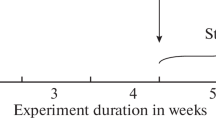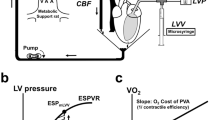Summary
Active stress, stress-time integral (STI) and total heat production of cat right ventricular papillary muscles were recorded during brief trains of isometric twitch contractions at muscle lengths less than or equal to optimal length. Individual muscles were subjected to a 10°C change in temperature, a change of stimulus frequency and the addition of isoprenaline sulphate (10−7 mol. 1−1). The STI-heat and stress-heat data were subjected respectively to linear and quadratic regression analyses. For both relations, the intercept (stress-independent heat) was unaffected by the frequency change, doubled by the temperature decrease and trebled by the addition of isoprenaline. None of the treatments had a significant effect on the first or second order coefficients of the stress-heat relation. The slope of the STI-heat relation was halved by lowering the temperature, increased 50% by the addition of isoprenaline and unaffected by stimulus frequency. Thus the energetic cost of a given stress increment was constant across conditions while that for a given STI increment was not. Stress is the better mechanical index of myocardial energy cost when the inotropic state is changing.
Zusammenfassung
An Papillarmuskeln vom rechten Ventrikel der Katze wurden die entwickelte Spannung, das Spannungs-Zeit-Integral (STI) und die gesamte Wärmeproduktion während kurzer Serien isometrischer Kontraktionen registriert bei Vordehnungsstufen unterhalb oder bei optimaler Länge. Die einzelnen Muskeln wurden einer Temperaturänderung von 10°C, einer Änderung der Reizfrequenz sowie einer Behandlung mit Isoprenalinsulphat (10−7 mol. ·1−1) unterworfen. Die Daten wurden einer linearen bzw. quadratischen Regressionsanalyse unterzogen. Durch Frequenzänderungen wurde der Schnittpunkt der Kurve mit der Ordinatenachse (spannungsunabhängige Wärme) für beide Beziehungen nicht beeinflußt, dagegen wurde der Achsenabschnitt durch die Temperaturabnahme verdoppelt und durch Zugabe von Isoprenalin verdreifacht. Keiner der Eingriffe hatte einen eindeutigen Effekt auf die Koeffizienten 1. oder 2. Ordnung der Spannungs-Wärme-Relation. Die Neigung der STI-Wärme-Kurve wurde durch Temperatursenkung vermindert und durch Verabfolgung von Isoprenalin gesteigert, war jedoch von der Reizfrequenz unabhängig. Der Energiebedarf für einen gegebenen Zuwachs an Spannung war also konstant, unabhängig von den Versuchsbedingungen; dagegen war der Energiebedarf für eine bestimmte Zunahme des Spannungs-Zeit-Integrals nicht konstant. Die Spannung ist der bessere mechanische Index für den myokardialen Energlebedarf, wenn der inotrope Status sich ändert.
Similar content being viewed by others
References
Chapman, J. B., C. L. Gibbs: An energetic model of muscle contraction. Biophys. J.12, 227–236 (1972).
Evans, C. L., A. V. Hill: The relation of length to tension development and heat production on contraction in muscle. J. Physiol. London49, 1–16 (1914).
Gamble, W. J., P. A. Conn, A. E. Kumar, R. Plenge, G. Munroe: Myocardial oxygen consumption of blood-perfused, isolated rat heart. Amer. J. Physiol.219, 604–612 (1970).
Gibbs, C. L.: Role of catecholamines in heat production in the myocardium. Circulat. Res.21, Suppl. 3, 223–230 (1967).
Gibbs, C. L.: Cardiac energetics. Physiol. Rev.58, 174–255 (1978).
Gibbs, C. L., W. R. Gibson: Effect of ouabain on the energy output of rabbit cardiac muscle. Circulat. Res.24, 951–967 (1969).
Gibbs, C. L., W. R. Gibson: Effect of alterations in the stimulus rate upon energy output, tension development and tension-time integral of cardiac muscle in rabbits. Circulat. Res.27, 611–618 (1970).
Gibbs, C. L., W. R. Gibson: Isoprenaline, propranolol, and the energy output of rabbit cardiac muscle. Cardiovasc. Res.6, 508–515 (1972).
Gibbs, C. L., P. Vaughan: The effect of calcium depletion upon the tension-independent component of cardiac heat production. J. Gen. Physiol.52, 532–549 (1968).
Gregg, D. E.: Physiology of the coronary circulation. Circulation27, 1128–1137 (1963).
Hartree, W., A. V. Hill: The regulation of the supply of energy in muscular contraction. J. Physiol. Lond.55, 133–158 (1921).
Hill, A. V.: Length of muscle, and the heat and tension developed in an isometric contraction. J. Physiol. London.60, 237–263 (1925).
Homsher, E. W., F. H. M. Mommaerts, N. V. Ricchiuti, A. Wallner: Activation heat, activation metabolism and tension-related heat in frog semitendinosus muscle. J. Physiol. London.220, 601–625 (1972).
Krasnow, N., E. L. Rolett, P. Yurchak, W. B. Hood, R. Gorlin: Isoproterenol and cardiovascular performance. Amer. J. Med.37, 514–525 (1964).
Monroe, R. G., R. H. Strang, C. G. La Farge, J. Levy: Ventricular performance, pressure-volume relationships and O2 consumption during hypothermia. Amer. J. Physiol.206, 67–73 (1964).
Rayford, C. R., E. M. Khouri, D. E. Gregg: Effect of excitement on coronary and systemic energetics in unanaesthetized dogs. Amer. J. Physiol.209, 680–688 (1965).
Sarnoff, S. J., E. Braunwald, G. H. Welch Jr., R. B. Case, W. N. Stainsby, R. Macrus: Hemodynamic determinants of oxygen consumption of the heart with special reference to the tension-time index. Amer. J. Physiol.192, 148–156 (1958).
Smith, I. C. H.: Energetics of activation in frog and toad muscle. J. Physiol. London.220, 583–599 (1972).
Sonnenblick, E. H., J. Ross, J. W. Covell, G. A. Kaiser, E. Braunwald: Velocity of contraction as a determinant of myocardial oxygen consumption. Amer. J. Physiol.209, 919–927 (1965).
Wendt, I. R., C. L. Gibbs: Energy production of rat extensor digitorum longus muscle. Amer. J. Physiol.224, 1081–1086 (1973).
Wiggers, C. J., L. N. Katz: Static and dynamic effort of the heart during ejection. Amer. J. Physiol.85, 229–250 (1928).
Author information
Authors and Affiliations
Additional information
With 4 figures and 1 table
Rights and permissions
About this article
Cite this article
Barclay, J.K., Gibbs, C.L. & Loiselle, D.S. Stress as an index of metabolic cost in papillary muscle of the cat. Basic Res Cardiol 74, 594–603 (1979). https://doi.org/10.1007/BF01907501
Received:
Issue Date:
DOI: https://doi.org/10.1007/BF01907501




